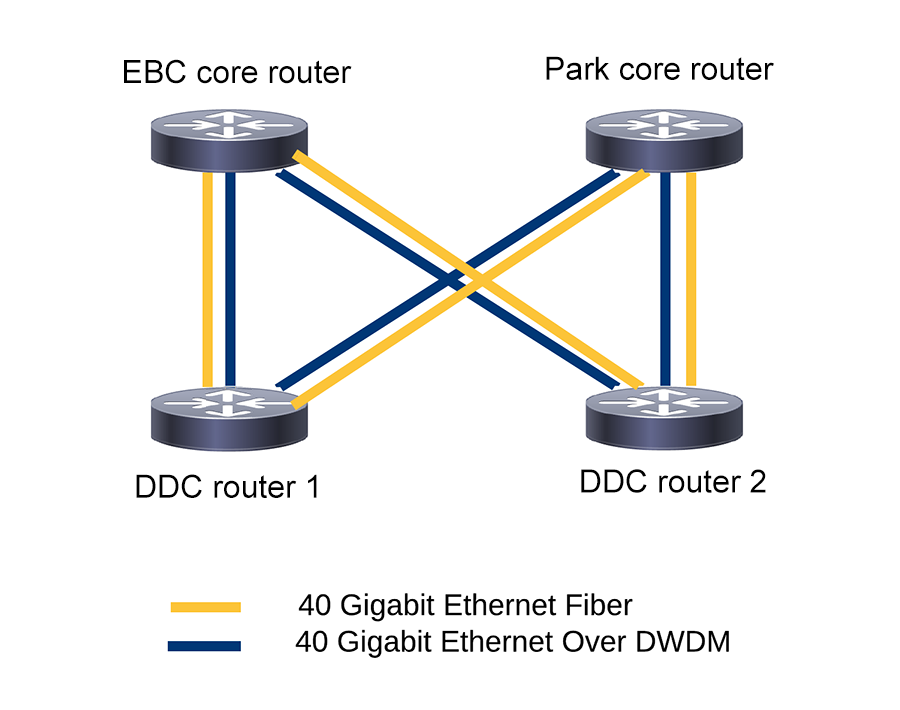You’re accessing archived content
This is archived content from the UIT website. Information may be outdated, and links may no longer function. Please contact stratcomm@it.utah.edu if you have any questions about archived content.
Network News: Fiber to DDC upgraded from 10 to 40 Gb
Note: This column is part of a new semi-regular feature that highlights current events in UIT's Network Services group.

Tim Urban,
senior engineer,
UIT Network Services
UIT's Network Services team has completed a major equipment upgrade, bringing eight links of Ethernet fiber that extend from campus to the Downtown Data Center (DDC) up from 10 Gb to 40 Gb, with the potential to be boosted to 100 Gb in the future.
Tim Urban, senior engineer in UIT's Network Services, said this is an important consideration in light of the fact that the University's need for bandwidth typically doubles every two years.
The upgrade doesn't add redundancy – backup fiber paths were already in place (see illustration, below). Bringing them all up to 40 Gb is more like buying connectivity insurance.
Only four of the eight fiber links (blue, in the illustration) are typically active. These primary fibers run over Dense Wavelength Division Multiplexing (DWDM). DWDM is a technology that puts data from different sources together on an optical fiber, with each signal carried at the same time on its own separate wavelength.
"It's basically a way to have multiple virtual fibers over a single pair of fibers," Urban said.
The yellow lines are "dark fibers" in industry parlance, a term for unused fiber optic cables. As demand for bandwidth increases, it's increasingly common to lay more fiber lines than currently needed for future use. But unused is a bit misleading. Should a network disruption occur, the dark fiber becomes a failover that allows traffic to flow unabated.
"This helps us sustain full connectivity between all of these (network) devices from the University to the data center," Urban said.
The criss-crossing fibers run between routers at Eccles Broadcast Center and Park Building to designated routers at the DDC. The north-south segments run down 4th South and 8th South.

This is an important intermediary step between the completed Campus Backbone Network (CBN) upgrade and an upcoming conversion of the DDC to an Application Centric Infrastructure (ACI) environment.
The 10-40 Gb upgrade accomplishes two things:
1. It aligns the bandwidth with core routers previously upgraded to 40 Gb during the network backbone project. The CBN links all campus buildings and structures, including the hospital, DDC, and the internet.
2. It readies the DDC to become a next generation data center using ACI processes. This undertaking will be discussed in more detail in July's Network News column, but essentially means more automation. While configuration changes are currently handled manually, in the ACI environment, service requests will be automatically provisioned "more like an Amazon Web Services experience," Urban explained. That multi-year project – which involves moving all servers in the DDC (about 2,000 ports) to new network hardware – will begin in 2018.
Urban noted that Network Services team projects are approached methodically, with careful consideration to minimize downtime for users. They typically involve initial design and testing, peer reviews during the Change Advisory Board (CAB) approval process, thorough documentation, and numerous validations after a change is made.
"This is our practice for everything from complicated but low risk projects to not too complex but very risky projects," Urban said. "Everything is step-by-step, like a flight check list."
Node 4
Our monthly newsletter includes news from UIT and other campus/ University of Utah Health IT organizations, features about UIT employees, IT governance news, and various announcements and updates.
